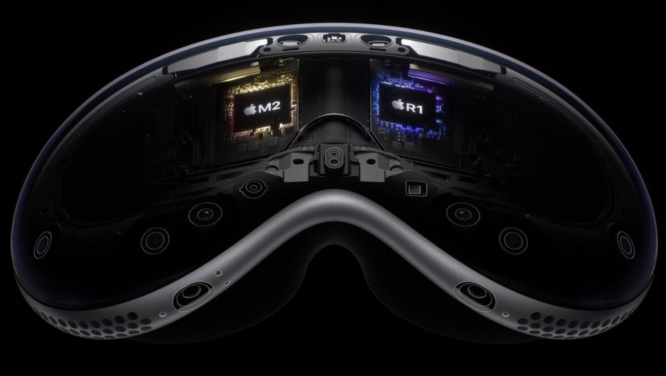Apple has introduced the highly anticipated Apple R1 microprocessor, a processor designed to power the Apple Vision Pro, a revolutionary mixed-reality headgear. The R1 processor is poised to redefine the immersive experience with its distinct capabilities and seamless integration with the M2 chip.
The Apple R1 processor takes center stage as a dedicated microprocessor meticulously designed to meet the requirements of mixed-reality headsets, including the Vision Pro.
The R1 processor gives users a new level of sensorial immersion and interactivity by working in tandem with the M2 chip, which powers Apple’s renowned MacBook Air.

What can the Apple R1 chip do?
The Apple R1 microprocessor supplements the M2 processor by acquiring responsibility for data processing from the Vision Pro headset’s extraordinary array of sensors.
With an outstanding collection of twelve cameras, five sensors, and six microphones, the R1 processor processes incoming data with remarkable speed.
This feat is accomplished in an astounding 12 milliseconds, which is eight times quicker than the human eye. This rapid processing is essential for minimizing delays and ensuring a seamless experience, thereby decreasing the likelihood of motion sickness and disorientation among users.
- Reducing seasickness and disorientation
With the Apple R1 chip, one of Apple’s primary goals is to address the motion nausea issues commonly associated with virtual and augmented reality experiences.
By processing sensory input in real-time, the Apple R1 processor allows users to perceive their surroundings with minimal latency.
Any discernible latency between physical movement and corresponding visual feedback can induce motion sickness and negatively impact the user’s comfort and experience.
The lightning-fast processing of the Apple R1 chip substantially reduces the likelihood of such issues, enabling smoother and more pleasurable mixed-reality interactions.
- Battery life factors to consider
The Vision Pro headset’s incorporation of both the R1 and M2 processors provides unparalleled performance but at a price.
With two processors operating concurrently, the battery life of the headgear is approximately two hours per charge. Users of the MacBook Air, who have come to appreciate the M2 chip’s remarkable energy efficiency, may be surprised by this development.

Due to the demanding processing requirements of the R1 processor, however, additional power consumption is inevitable. Users must take this limitation into account when planning extended use of the earpiece and make provisions for recharging as necessary.
The expensive cost of advanced technology
The Vision Pro headset’s overall price is unavoidably affected by the innovative design and cutting-edge technology that went into creating the Apple R1 microprocessor.
At $3499, the headset represents a substantial investment. While the incorporation of both the R1 and M2 processors undoubtedly contributes to this higher price, it is essential to acknowledge the Vision Pro’s extensive array of cutting-edge features and capabilities.
As with any premium product, the price of Apple’s products reflects the level of technology, sophistication, and immersive experience it seeks to provide to its most discerning customers.
Together, the Apple R1 chip and the M2 processor propel the Apple Vision Pro headgear into its own classification. By incorporating the R1 chip’s lightning-fast processing capabilities, Apple has mitigated the problems associated with motion sickness, ensuring a more fluid and immersive mixed-reality experience.
Despite the impact on battery life and the higher price, the Vision Pro’s innovative technology and unrivaled performance validate its status as a game-changer in the mixed reality industry.



